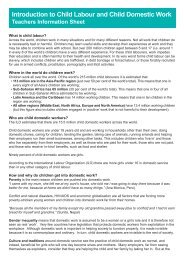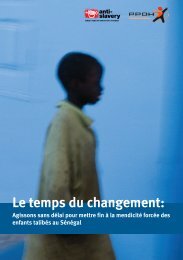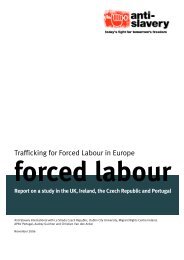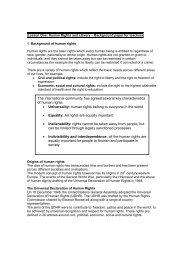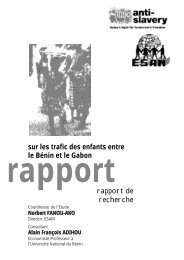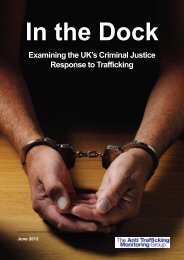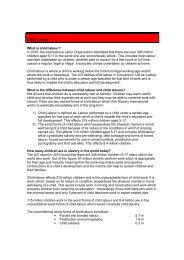In the Dock
Full report (1810.59KB) - Anti-Slavery International
Full report (1810.59KB) - Anti-Slavery International
Create successful ePaper yourself
Turn your PDF publications into a flip-book with our unique Google optimized e-Paper software.
<strong>In</strong> <strong>the</strong> previous two ATMG reports, 4 it was argued that <strong>the</strong> UK should appoint an independent Anti-Trafficking Commissioner 5 with statutory powers, to fulfil <strong>the</strong> role of an independent monitoring bodyrecommended by Article 29.4 of <strong>the</strong> Convention. It is our conclusion that <strong>the</strong> continued absence of anAnti-Trafficking Commissioner exacerbates <strong>the</strong> situation described in this report.Trafficking in <strong>the</strong> UKKnowledge about <strong>the</strong> manifestation of trafficking and current trends is essential for an effectivecriminal justice response, and especially for planning any future strategies. The research found thatpolicy is yet to take into account <strong>the</strong> constantly changing nature of <strong>the</strong> crime, <strong>the</strong> complexities oftrafficking and its impact on trafficked persons.<strong>In</strong> <strong>the</strong> past two years, data from <strong>the</strong> National Referral Mechanism suggests an upward trajectory in <strong>the</strong>number of referrals of potential trafficked persons. The provisional 2012 NRM statistics alone are saidto have increased by 25% on <strong>the</strong> 2011 figures, which are higher than previous years. 6 Fur<strong>the</strong>rmore,according to <strong>the</strong> UKHTC, <strong>the</strong> referrals in <strong>the</strong> first quarter of 2013 (yet to be published) are said toexponentially exceed <strong>the</strong> 2012 levels. Also, for <strong>the</strong> first time in 2012, <strong>the</strong> UKHTC published datareveals that trafficking for forced labour exceeds trafficking for sexual exploitation in <strong>the</strong> UK and <strong>the</strong>number of identified trafficked men has increased. 7The case for a comprehensive anti-trafficking lawThe research found a disproportionally low number of convictions for trafficking compared to <strong>the</strong>increasing number of potential trafficked persons. The reasons for this are multiple, includingtrafficking not being made a priority in policing plans.Moreover, <strong>the</strong> current system of data collection gives a confused and potentially misleading picture onhow successful <strong>the</strong> UK is in tackling trafficking. Two government departments ga<strong>the</strong>r differentstatistics on trafficking prosecutions and convictions: a) <strong>the</strong> Ministry of Justice (MoJ) collects data onconvictions and prosecution of trafficking where <strong>the</strong> trafficking offence charged is <strong>the</strong> principal offenceon <strong>the</strong> indictment; 8 and b) <strong>the</strong> Crown Prosecution Service (CPS) collects data from <strong>the</strong>ir casemanagement system where cases involving a trafficking charge are flagged even if <strong>the</strong> trafficker isfound guilty of o<strong>the</strong>r offences at trial and not <strong>the</strong> trafficking charge. The result is a situation, wheredifferent statistics are presented by different departments, leading to confusion over <strong>the</strong> number ofperpetrators actually brought to justice for trafficking. Fur<strong>the</strong>rmore, conviction statistics are notdisaggregated, rendering it almost impossible to ascertain how many child traffickers are prosecuted.An Anti-Trafficking Commissioner would be able to assist in this area by using <strong>the</strong>ir statutory power torequest information and determine <strong>the</strong> correct number of prosecutions and conviction of traffickers.The research concludes that individual trafficking offences in different pieces of legislation isunhelpful. Many CJS actors are unaware of <strong>the</strong>ir existence altoge<strong>the</strong>r or are uncertain in relation to<strong>the</strong> application of <strong>the</strong>se laws. This is a particular problem in cases of labour trafficking, as <strong>the</strong> offenceis housed in an immigration act. It was also found that <strong>the</strong> scattered nature of <strong>the</strong> legislation ignores<strong>the</strong> complexity of <strong>the</strong> crime.4The Anti-Trafficking Monitoring Group, Wrong kind of victim? One year on: an analysis of UK measures to protect trafficked persons(2010), and All Change: Preventing Trafficking in <strong>the</strong> UK (April 2012).5A call recently taken up by <strong>the</strong> centre-right think-tank report: Centre for Social Justice, It Happens Here: equipping <strong>the</strong> UnitedKingdom to fight modern slavery (March 2013). Available at:www.centreforsocialjustice.org.uk/UserStorage/pdf/Pdf%20reports/CSJ_Slavery_Full_Report_WEB(5).pdf [last accessed 12 April2013].6UK Human Trafficking Centre, NRM provisional statistics for 2012 [Online]. Available at: www.soca.gov.uk/about-soca/about-<strong>the</strong>ukhtc/national-referral-mechanism/statisticslast accessed March 2013].7SOCA, (2012) UKHTC: A Baseline Assessment on <strong>the</strong> Nature and Scale of Human Trafficking in 2011 [Online]. Available at:www.soca.gov.uk/news/462-human-trafficking-assessment-published [last accessed March 2013].8Meaning <strong>the</strong> trafficking offence has <strong>the</strong> heaviest tariff (14 years) out of <strong>the</strong> offences charge on <strong>the</strong> indictment.10



